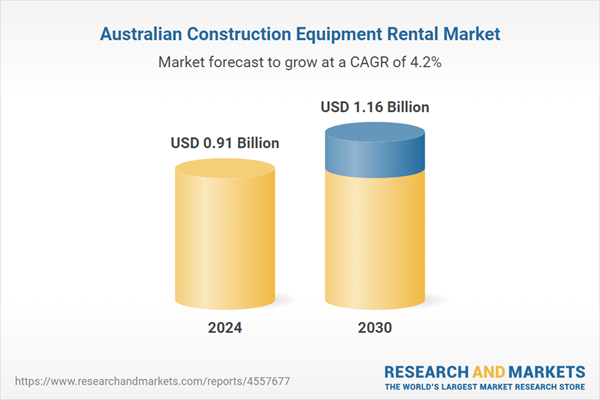Dublin, Aug. 29, 2025 (GLOBE NEWSWIRE) — The “Australia Construction Equipment Rental Market, By Region, Competition, Opportunities & Forecast, 2020-2030F” has been added to ResearchAndMarkets.com’s offering.
The Australian Construction Equipment Rental Market was valued at USD 0.91 Billion in 2024 and is expected to reach USD 1.16 Billion by 2030, rising at a CAGR of 4.23%.
The Australia construction equipment rental market is witnessing notable traction as contractors and project developers seek capital-efficient ways to access heavy machinery. High ownership costs, routine maintenance expenses, and depreciation risks have shifted the preference toward renting equipment, particularly among small to medium enterprises. The growing scale of public and private infrastructure development, coupled with government investments in transport, utilities, and energy sectors, is further fueling market growth.

Key growth drivers include increasing urbanization that demands rapid construction activity, a shortage of skilled labor, which drives the need for technologically advanced machinery, and evolving environmental regulations pushing for low-emission, newer rental fleets. In November 2024, the Utilities Construction Outlook – Australia report indicated a significant increase in renewable electricity initiatives, resulting in the country’s utility construction industry’s most substantial growth in 15 years.
The report highlights that, over the last three years, the overall value of utility construction has risen by 41%, reaching a historic peak of USD 40 billion in 2023/24, exceeding the former record of USD 38 billion established in 2012/13. Furthermore, the market is also benefiting from the integration of digital technologies such as telematics, IoT, and asset tracking solutions that enhance operational efficiency and reduce downtime. These factors are creating a supportive environment for rental service providers to expand their fleets and service networks.
Trends such as equipment-as-a-service models, increased adoption of electric and hybrid machinery, and shift toward compact and versatile equipment are gaining traction. However, the market faces challenges including fluctuating rental rates, maintenance liabilities despite rental contracts, and lack of trained operators. The presence of aging machinery in rental fleets and inconsistent servicing standards can also impact equipment reliability. Moreover, economic slowdowns and delays in large-scale construction projects may influence rental demand.
Market Drivers: Surge in Infrastructure Projects
Australia is investing heavily in transport, energy, and urban infrastructure, driving demand for construction machinery on a project-by-project basis. Renting equipment allows contractors to access specialized machinery without upfront capital costs, which aligns with the varying timelines and machinery needs of infrastructure projects. As governments and private developers pursue long-term infrastructure initiatives, from highway upgrades to renewable energy installations, rental firms are positioned to provide scalable solutions.
The flexibility of rental agreements allows contractors to adjust equipment usage as project demands evolve, minimizing idle inventory. This factor supports the growing preference for short-term and project-based rentals across civil, commercial, and public works. Furthermore, rental companies are expanding their fleets and service offerings to meet this rising demand, reinforcing their role as essential partners in major construction efforts. The pace and scale of infrastructure development continue to be a major force behind the sustained expansion of equipment rental services across the country.
Key Market Challenges: Unpredictable Rental Rates and Price Competition
Frequent fluctuations in rental rates create uncertainty for both rental companies and clients. The market is highly competitive, with providers offering discounted rates to gain short-term business. While this benefits customers, it pressures rental companies to operate on narrow profit margins. The price-sensitive environment can lead to cost-cutting in maintenance, support, or upgrades, which affects service quality in the long term.
Many small rental firms struggle to maintain profitability when competing against larger providers that can afford aggressive pricing strategies. Inconsistent pricing also complicates contractors’ budgeting and may delay decision-making when planning equipment needs. This unpredictability hinders the long-term stability of the rental market and discourages smaller companies from investing in advanced or specialized equipment. Price volatility not only threatens financial viability for rental firms but also undermines the consistency and dependability that customers seek in rental agreements.
Key Market Trends: Growth of Equipment-as-a-Service (EaaS) Models
The rental market is increasingly adopting Equipment-as-a-Service (EaaS) frameworks, where clients pay for usage time, output, or performance instead of just the rental duration. This model offers flexible contracts, lower upfront costs, and enhanced customer value by bundling maintenance, upgrades, and digital monitoring into one package. Contractors benefit from predictable expenses and better alignment of equipment use with project phases. EaaS allows rental companies to differentiate their offerings by providing insights into equipment performance, energy efficiency, and operational health.
The shift to service-based models also promotes closer customer relationships, continuous engagement, and stronger retention. This trend is growing across urban construction projects, where budgets are tighter and productivity metrics are closely monitored.
Rental providers are investing in IoT platforms and data analytics to enable real-time usage tracking and support performance-based billing. As customers seek more convenience and accountability, EaaS is transforming how equipment rental is marketed and delivered in Australia.
Key Market Players:
Seven Group HoldingsKennards HireDelta Rent Pty LtdOnsite Rental Group LimitedUnited Rentals Australia Pty Ltd (Orange Hire)Brooks Hire Service Pty LtdProquip Rental & Sales Operations PTY LTDPorter GroupCJD Equipment Pty LtdWilliam Adams Pty Ltd
Key Attributes:
Report AttributeDetailsNo. of Pages88Forecast Period2024 – 2030Estimated Market Value (USD) in 2024$0.91 BillionForecasted Market Value (USD) by 2030$1.16 BillionCompound Annual Growth Rate4.2%Regions CoveredAustralia
Report Scope:
In this report, the Australia Construction Equipment Rental Market has been segmented into the following categories, in addition to the industry trends which have also been detailed below:
Australia Construction Equipment Rental Market, By Type:
ExcavatorsSkid Steer LoaderWheel LoaderMotor GraderDozerBackhoe LoadersOthers
Australia Construction Equipment Rental Market, By End User:
Oil & GasConstructionInfrastructureManufacturingOthers
Australia Construction Equipment Rental Market, By Region:
New South WalesVictoria & TasmaniaQueenslandWestern AustraliaNorthern Territory & Southern Australia
For more information about this report visit https://www.researchandmarkets.com/r/yac5z
About ResearchAndMarkets.com
ResearchAndMarkets.com is the world’s leading source for international market research reports and market data. We provide you with the latest data on international and regional markets, key industries, the top companies, new products and the latest trends.
Australian Construction Equipment Rental Market


